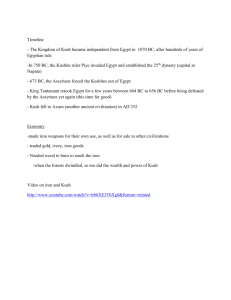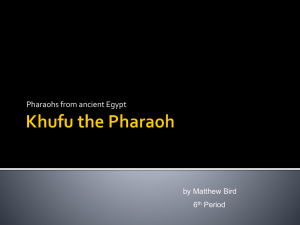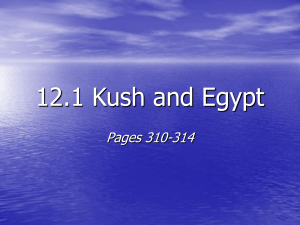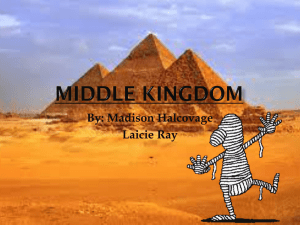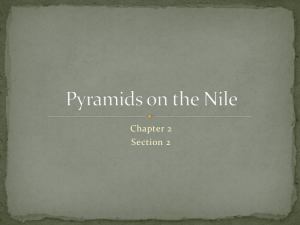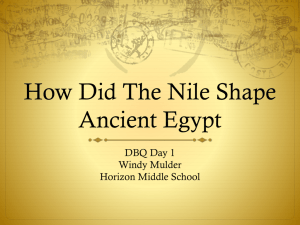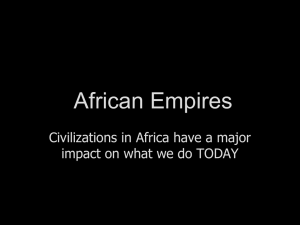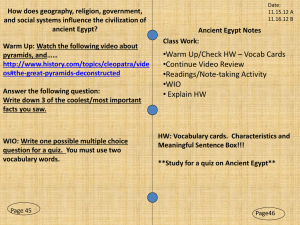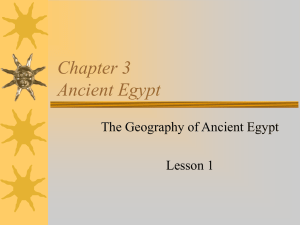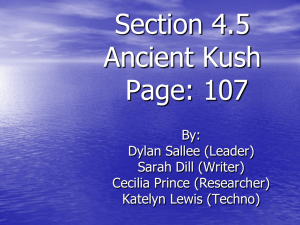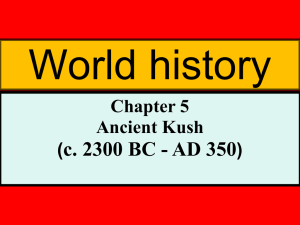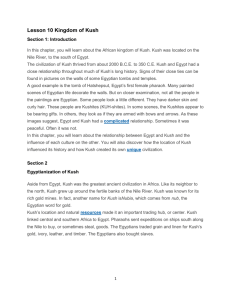Ancient Africa
advertisement
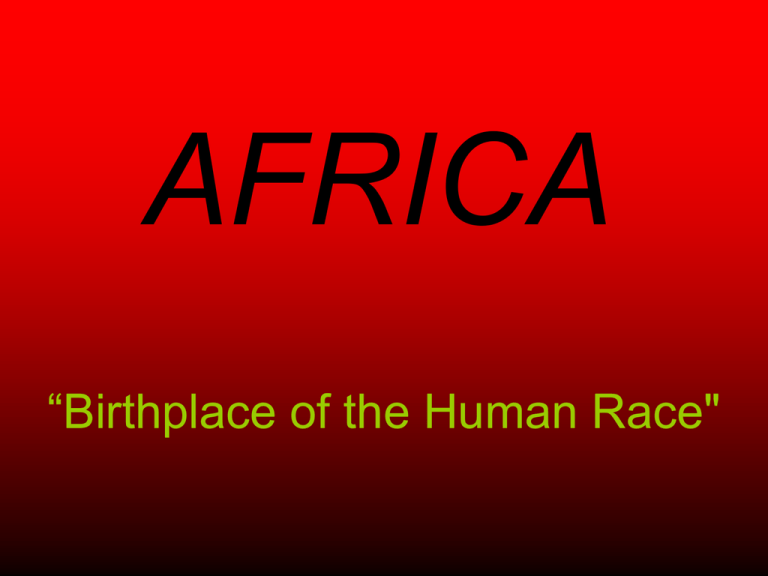
AFRICA “Birthplace of the Human Race" Week 1 Location, Location, Location How does the supply of resources and demands of society affect the production, distribution, price, and consumption of goods and services? The Nile River Valley • Home to two major civilizations Egypt and Kush. • Longest river in Africa and in the world (4,445 miles) • Flows north from equator into Mediterranean Sea through Egypt, Ethiopia, Sudan, Burundi • Worshipped as a life-giving god (Hapi) • Important to both Egyptians and Kushites • 22% runs through Egypt, creating a fertile green valley across the desert. • Usage – Kushites used it for cleaning, drinking, bathing, and irrigating crops – Egyptians used it for farming Overview of Africa • “Birthplace of the human race" oldest evidence of human-like creatures and people found in eastern and southern Africa. • 2nd largest continent; 3 times the size of the continental United States Overview of Africa cont’d • Rivers: The Nile, Congo or Zaire, Niger, and Zambezi. Nile valley was the cradle of one of the earliest civilizations (Ancient Egyptians) • Oceans: Few natural harbors; The Atlantic Ocean borders Africa to the west, the Indian Ocean borders the east, and the Mediterranean borders the north. The Atlantic and Indian Oceans meet to border the south. • Landforms: Has many environments ranging from the most arid of desert wastes to tropical rain forest, savanna, vast swamps, even snow-capped mountains. Home to the largest desert in the world, the Sahara. Majestic snow-capped peaks of Mt. Kenya and Mt. Kilimanjaro are located near the Equator. • Prime Meridian and Equator: Runs through Africa (vertically & horizontally, respectively) Regions of Africa www.africaaction.org/bp/regmap.htm North Africa: mild temperature, coastal plains, inland deserts West Africa: narrow coast, major rivers (most rivers are not very navigable) East Africa: plateau, grasslands Central Africa: equator, rainforest, hot, humid Southern Africa: highlands, fertile Contributions of Ancient Africa Obelisks http://www.crystalinks.com/obelisks.html Flat Roofed Homes Pyramids Mummification Unique Gods and Goddesses Written Language http://www.mrnussbaum.com/egyptiandieties.htm Systems of Irrigation Number system including fractions Papyrus Hieroglyphics Generator http://kids.discovery.com/fansites/tutenstei n/interactive/hierogenerator.html Week 2 Background: Early Civilizations of Africa Kingdom of Kush 3800 BCE to 1400 CE • Location: Upper Nile River • Major Export: Iron Weapons and Tools, Ivory, Incense, Gold , timber, elephant tusks, ebony, leopard skin, ostrich feathers, emeralds • Natural resource: Nile River, Gold Mines • Industries: Farming, mining, trading, defense (army) • Agricultural crops: Yams (sweet potatoes), beans, rice, onions, sorghum, millet, papaya, gourds, cattle, sheep, goats, poultry, cotton, and peanuts. • Economic specialization: traders, miners, farmers, blacksmiths, soldiers • merchants & kings (wealthy) • Religion: The same gods and goddesses as ancient Egypt with a few extra thrown in like the 3-headed Lion God. • Clothing: In the beginning, the same as Egypt - white, loose, cool cotton clothes. As time went on, the Nubians began dressing more like the people south of the Sahara, dressing in colorful cotton Map of the Kingdom of Kush/Nubia • Nubian River Civilization: Kush conquered Nubia. Then Nubia conquered Kush • Ancestors are called Nubians • Ruled by Egypt-500 years (1000 B.C. broke from Egypt) . • 724 B.C., King Piankhi invaded Egypt & defeated the Egyptian army • Kushite king ruled Kush & Egypt • Adoptions: temple, monuments & pyramids like Egypt • 671 B.C., Assyrians (iron swords) invaded Egypt & defeated the Kushites (bronze weapons)-Kushites left Egypt • Kushites learned to use iron • New capital: Meroë-iron production • Traded with Mediterranean & Red Sea Regions (wealth) • Kingdom of Axum (Red Sea trading power) invaded Kush & ended Kushite domination of Northeast Africa – Axum traded with Egypt, Greece, Rome, India, & Persia (Christianity from Rome) Ancient Egypt http://egypt.mrdonn.org/index.html Consider Major Exports Natural resources Industries Agricultural crops Economic specialization People Religion Clothing Map of the Kingdom of Egypt Earliest people YOUR TURN 1. Using information from Nystrom Atlas of World History and the Notable Facts Record Form, work in pairs to determine and record notable information regarding Ancient Africa. 2. Prepare to participate in Each One, Teach One. More Landforms of Ancient Africa Plateaus and Escarpments Makonde Escarpment - Tanzania http://www.ded-tanzania.de/fglw/newal_pictures.html These kept people OUT of interior Africa. Table Mountain in Cape Town, South Africa www.corbis.com/Charles O'Rear http://www.mrdowling.com/611africatoday.html Mount Kilimanjaro East African Mountains THIS is why we see snow at the Equator! Rivers in Africa Settlements developed at the base of the escarpment and along river banks. •Zambezi River- in southern Africa •Congo River- in the Dem. Rep. of the Congo •Nile River- eastern and northern Africa •Niger River- west Africa http://www.kented.org.uk/ngfl/rivers/River%20Articles/victoriafalls.htm Victoria Falls Victoria Falls "Hyped up" since 1855 when Dr. David Livingstone first set eyes on Victoria Falls, today the gentle rumbling still reminds us that this is one of the finest natural spectacles on earth! Other issues with rivers? Flooding in Mozambique River Transportation • River Transportation impacted by cataracts http://www.zamsoc.org/photo_gallery/pages/f_scenery04_jpg.htm http://www.zamsoc.org/photo_gallery/pages/e_aerial03_jpg.htm • Port cities developed along fall lines & at mouth of rivers (deltas)-site & situation • Few natural harbors in Africa (thin coast) Settlement in Cities and Towns •European styles of settlement patterns•Town Square A town square in Lagos, Nigeria http://www.marekinc.com/PhotosHeadllines2003.html Now look at the settlement!! Which are the top 3 populated countries? Nigeria Egypt Ethiopia Climate Patterns • Africa is the only continent to have the Equator, Prime Meridian, and BOTH Tropic Lines to run through it. A F R I C A N C L I M A T E •There are similar climate patterns found at the north and the south of the continent EXCEPT that they’re... reversed and mirrored ---WHY?? Tropical Rainforest Desert Savannah Mediterranean Coastal Settlements & Countries • Many landlocked countries • Interior of Africa is a PLATEAU • Africa is a storehouse of mineral wealth: gold , copper, and diamonds • Africa can make money by exporting RAW MATERIALS and then purchasing what they need by importing MANUFACTURED GOODS. • Potential for HYDRO-ELECTRIC power. (p.476) Note the disparity of wealth!!! $ $ $ $ http://www.africanculturalcenter.org/5_2_3wealth.html HOWEVER... •Africa has a lack of sustainable agriculture: •because of the lack of arable land & seasonable rainfall... •and the problem of infertile soil. • There is also an extensive range of climates: from desert to rainforests **Arid vs. semi-arid lands** • Desertification: The Sahara is slowly spreading southward. • Finally, there are scarce water resources: Oasis, wadis, “water holes” • Man-made: temporary water deposits & reservoirs, wells QUESTIONS • How might the physical characteristics of Africa explain starvation? • Why was it difficult for explorers to get to the middle of Africa? • What are some characteristics of Africa’s climate? • Why is there a large population along the coast in Africa? • What kinds of resources does Africa have that help its economic base? Week 3 African Visual Art and Architecture • Buildings • Pottery • Some early life-size stone statues come from Egypt • Anansi Art-Petroglyphs (See slideshow) Buildings • Kushites lived in rectangular homes made from sun-baked mud • Others lived in palm-wood homes • Wealthy homes were built using fire hardened brick; they had a courtyard on the eastside to take advantage of the morning sunlight. • Herders lived in portable beehive-shaped huts covered with animal skin or reeds • Some cities were surrounded by walls and moats and they had streets, palaces, temples, government buildings, shrines with fountains, observatories, and baths. • Rich Kushites built pyramid tombs similar to those of Egyptians Religion • Profess a wide variety of religious beliefs • Polytheists-People Egypt and Kush worshipped Isis, Osiris, Ra, and the Amen. • Monotheists-People in West Africa (Bantu) worshipped a sky god or sun god • Around 300 AD African religious belief changed: North and East Africans converted to monotheistic faith (Christianity). St. Augustine, great Christian theologian, from North Africa. Today • approximately 46.5% are Christian • 40.5% are Muslim, • 11.8% follow indigenous African religions Music and Dance • West Africa- blues, jazz, reggae, rap, and rock and roll have roots in West African culture • Modern African music- highly-complex choral singing of southern Africa; dance rhythms-Congo music African Literature • Folktales (stories, word of mouth) – legends, fables, jokes, tall stories, and fairy tales; many involve mythical creatures and magical transformations. • oral and written • primarily a tradition of oral artistry, passed on by memorizing, performing and reciting – folklore, verbal art, oral literature, or (more recently) orature • very little written until the 20th century • purpose of text: entertainment, instruction, and commemoration • Forms of literature: prose, verse, and proverb What are African Proverbs? Expressions of wisdom and keys to understanding the African ways of life in the past and in the present. Example It takes a village to raise a child. (West Africa) Some Empires of Africa • Egyptian Empire (1570 BC – 1070 BC) http://www.pbs.org/empires/egypt/ • Kushite Empire (760 BC – 656 BC) http://wsu.edu/~dee/CIVAFRCA/KUSH.HTM • Ghana Empire (750 AD - 1076 AD) http://www.accessgambia.com/information/ghana.ht ml Week 4 Location, Location, Location How does the supply of resources and demands of society affect the production, distribution, price, and consumption of goods and services? Defend the following statement in the context of Ancient Africa: Location is destiny.
